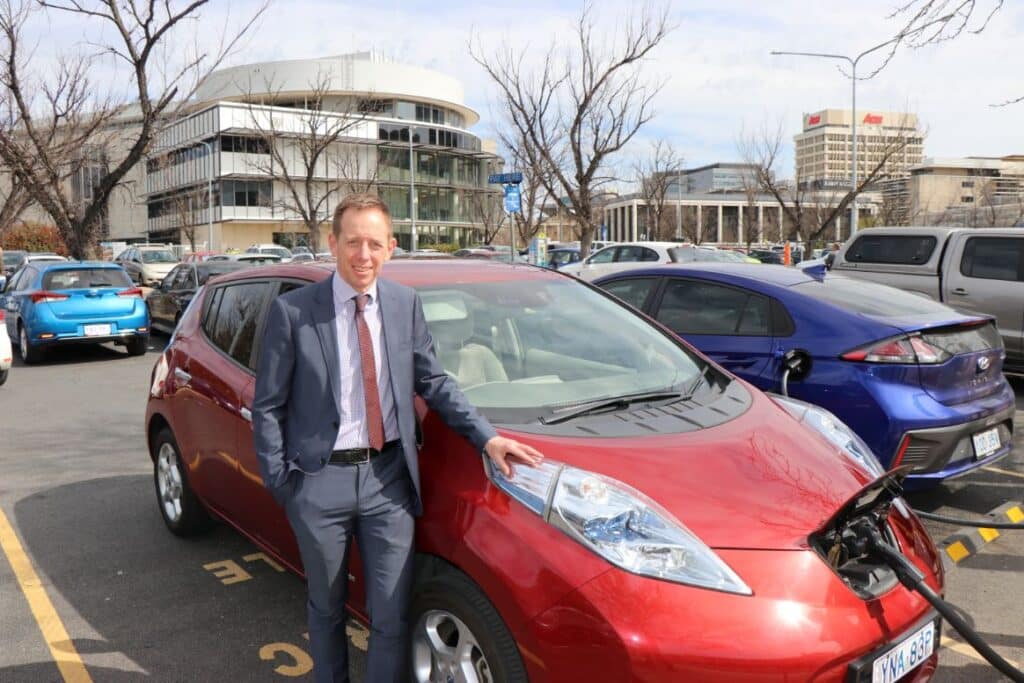The ACT has the highest ownership of electric vehicles (EVs) per capita – and the number of EVs in the ACT is growing rapidly, Darryl Bourke, branch secretary of the Australian Electric Vehicle Association ACT, said this week.
Canberrans bought 1,000 electric vehicles (EVs) in the first three months of this year. Last year, there were 3,000 EVs registered in the ACT; by the second week of April, there were 4,000 – a 33 per cent increase in little more than three months, Mr Bourke observed.
In March, 19 per cent of newly registered ACT cars were EVs – almost double the Electric Vehicle Council’s estimate of 10 per cent for the year 2022, Mr Bourke noted.
“Registrations are following a typical take-up S-curve,” Mr Bourke said.
Battery electric vehicles now represent more than 1.2 per cent of the total ACT passenger vehicle fleet. Battery electric vehicles are defined as those whose batteries require charging from an external source, and do not include plug-in hybrid or non-rechargeable hybrid vehicles.
Mr Bourke lists several benefits of electric vehicles: they produce no emissions; they are great to drive; they are quiet; owners can recharge at home; their sporty acceleration; and they have fewer moving parts, so need less servicing.
“The registration data shows that there is a clear appetite for zero emissions transport in the ACT,” Shane Rattenbury, ACT Minister for Water, Energy and Emissions Reduction, said.
The ACT Government has set a target that by 2030, 90 per cent of new vehicles sold will be electric vehicles, and both Mr Rattenbury and Mr Bourke are confident the ACT will meet that target.
- ACT to phase out fossil fuel-powered vehicles by 2035 (18 July 2022)
- Zero emission vehicles will be ‘easier and cheaper to access’, ACT Government says (20 July 2022)
In October, the Electric Vehicle Council’s State of EVs annual report showed that the ACT led the way on ZEV uptake and policy, Mr Rattenbury said. ZEV sales at the time sat at 9.5 per cent, while the average sales uptake for EVs across Australia was 3.39 per cent. NSW followed the ACT with the second highest rate of uptake, sitting at 3.7 per cent.
The government offers free vehicle registration, stamp duty exemption, and interest-free loans under the Sustainable Household Scheme. To date, 123 new EVs and 47 used EVs have been approved under the scheme.
“These programs will generate a well-developed second-hand market as a way of ensuring EVs become available sooner for all Canberrans,” Mr Rattenbury said.
Mr Bourke agrees that ACT Government support for electric vehicles is “a factor in the ACT having a higher uptake per capita” than other jurisdictions.
“The ACT benefits from its very engaged and progressive population,” Mr Rattenbury said. “Canberrans have always been keen early adopters of actions that reduce the effects of climate change, and the uptake of EVs is an example of that.”
The government is transitioning its own fleet to entirely electric: 250 zero and low emissions vehicles are already in the fleet, and another 130 are on order.
Electric vehicles cost at least $40,000, but Mr Rattenbury expects EVs will cost as much as a fossil fuel car before long.
“EV prices are falling, and we expect price parity in the next few years,” Mr Rattenbury said.
“Fuel and maintenance savings also mean that Canberrans save approximately $2,000 on running costs each year.”
“While the upfront price of EVs is coming down closer to non-EVs, if you do a Total Cost of Ownership (TCO) evaluation, in most cases the EV is more cost effective,” Mr Bourke said.
Australia was once considered a bad market for electric vehicles, but Mr Rattenbury believes this is changing under the new Federal Government.
“In Australia, we are still lagging behind much of the rest of the world in the transition to EVs, but we are catching up,” he said.
Last July, for instance, the Federal Government implemented a fringe benefit tax exemption to encourage employees to purchase electric vehicles.
“It’s a very attractive deal for salaried workers with access to a notated lease,” Mr Bourke said.
This week, the Federal Government launched a loan discount program, offering up to $2,500 off the price of green car loans. The government also intends to establish a fuel efficiency standard, as the National Electric Vehicle Strategy, also published this week, sets out.
Mr Rattenbury finds this encouraging. “More incentives and policy changes like these will increase the demand of EVs in Australia, which will attract more suppliers.”
“Australia is improving as a country worth selling EVs into,” Mr Bourke said. “State and Federal government initiatives have contributed. A proper fuel emissions standard like Europe has is needed to bring Australia in line with the global market.”
Canberrans considering purchasing an electric vehicle should attend one of the government’s free workshops providing advice and up to date information, Mr Rattenbury advised.
The AEVA will hold EV experience days this year, as they did at last weekend’s Ginninderry Inspire Festival.
“AEVA believes that the best way to find out about the benefits of an EV is to own one,” Mr Bourke said. “The second-best way is to talk to an owner.”



